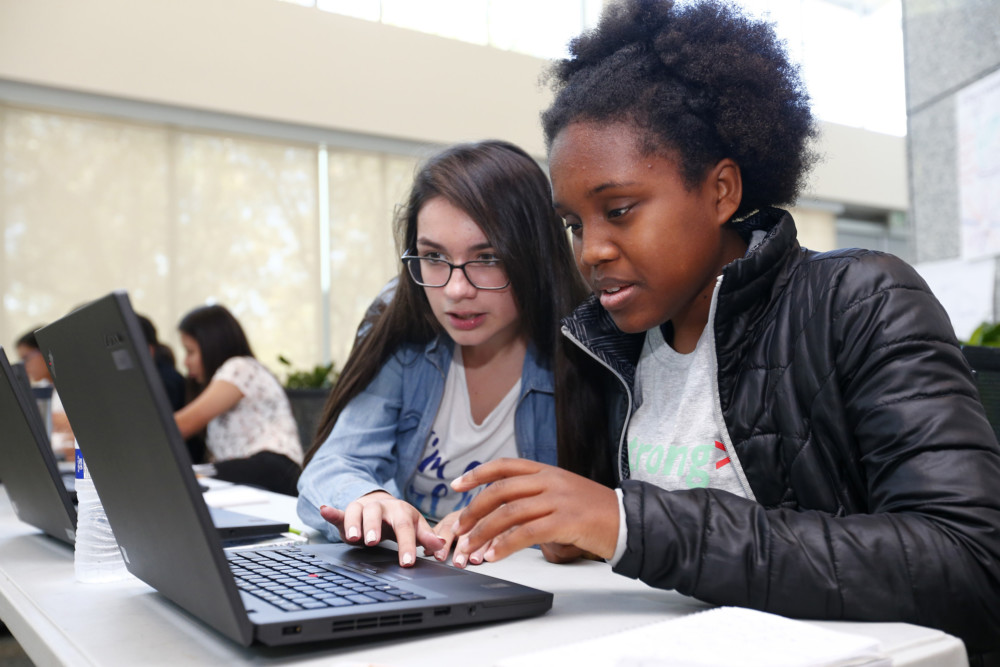By Stephen Singer
The Hartford Courant
WWR Article Summary (tl;dr) According to National Science Foundation data, Black, Hispanic and other minority women make up fewer than 5 percent of employed scientists and engineers. Across the country, several groups are networking and organizing to find creative ways to change that statistic.
The Hartford Courant
Educators are looking for ways to help young black women move into the growing field of science, technology, engineering and math, known as STEM.
Kadri Williams, a Windsor High School senior interested in a career in science and engineering, had a quick and positive reaction to Pratt & Whitney’s jet engine manufacturing plant in Middletown during a visit last fall.
“I felt at home,” she said.
Williams, 17, said she developed an early interest in technology as a child, asking lots of questions — “What’s that wire? What does it connect to?” — of electricians who worked on her parents’ house.
Williams, who is interested in robotics and electrical or mechanical engineering, would join a small group.
Black, Hispanic and other minority women make up fewer than 5 percent of employed scientists and engineers, according to National Science Foundation data cited by the National Girls Collaborative Project, an advocacy group.
Advocates of broader opportunities in education and the workforce and efforts to hire critically needed engineers, mathematicians and scientists are working to improve those numbers.
“It’s still predominantly male and white,” said Adrienne Cochrane, chief executive officer of the YWCA Hartford Region, which is working to draw more young black women into STEM. “The future says it’s STEM. Liberal arts in many ways is dying and dead.”
For the YWCA, which promotes social justice, working to broaden science and technology education is a natural fit by introducing young minority women to engineering, math and similar fields, opening “the door to opportunity,” she said.
Across the country, several groups are networking and organizing to bring more young black and Hispanic women into STEM.
The efforts are helped by public service ads promoted by major corporations, Instagram and Twitter accounts called SheCanStem and even the 2016 movie “Hidden Figures,” a story about three black female mathematicians who played key roles in the early years of the U.S. space program.
Several Connecticut schools and United Technologies Corp. have joined the effort to broaden the workforce of engineers and others in technology, fill a much-needed workforce in aerospace and defense manufacturing, and make sure that the workforce is diverse and that youngsters have the chance to realize their potential.
UTC is working with EarthEcho International, an environmental nonprofit group, to make STEM jobs appealing to young black and Hispanic women.
Randy Bumps, who heads up corporate responsibility at UTC, the parent company of jet engine manufacturer Pratt & Whitney and Collins Aerospace, said the conglomerate is making a “concentrated community investment” by broadening the STEM workforce.
In addition, Paul Eremenko, UTC’s chief technology officer, has urged greater efforts to make the aerospace manufacturing workforce more diverse as a “talent pool” is created, Bumps said.
Math and science aptitude tests show little difference between boys and girls through their senior year in high school, he said. By ninth grade, more than 20 percent of boys and about 8 percent of girls are interested in pursuing technology and engineering courses, he said.
“What that demonstrates is we’ve got to change the perception of careers,” Bumps said. “We’ve got to show girls … they’ve got to see engineers in roles who look like them, had the same aspirations, the same background.”
UTC and others pushing for expanded STEM education won’t stop investing in high school programs, but will reach further down into sixth through eighth grades, which Bumps called “critical junctures” of decision-making by youngsters, he said.
The Young Women’s Leadership Corps, a youth development program that teaches skills in personal growth, financial literacy and career and college readiness, promoted the STEM program that drew 110 teenagers.
Uneeder Ruth, program director of the YWLC, said the program in Hartford area high schools has helped teach youngsters skills that lead to more confidence.
“When they come in the program, they don’t feel empowered, they don’t feel good about themselves or comfortable speaking publicly,” she said.
They learn to “find their own voice,” Ruth said.
Maryam Kabal, who also is a senior at Windsor High School, said she got involved in the program because it’s a “great way to connect with other young girls.”
“It’s really important we have an all-female group to empower each other,” Kabal, 17, said. “It makes it easier to see yourself, to relate to them.”














































































































































































































































































































































































